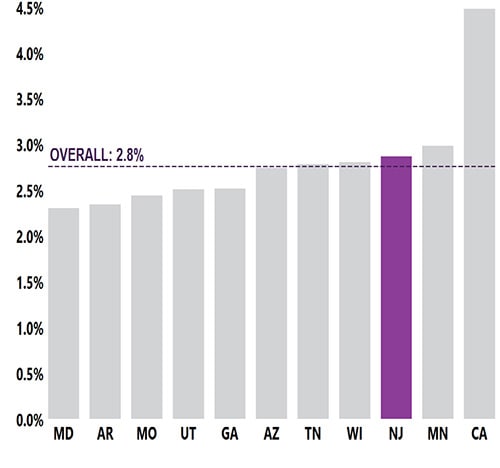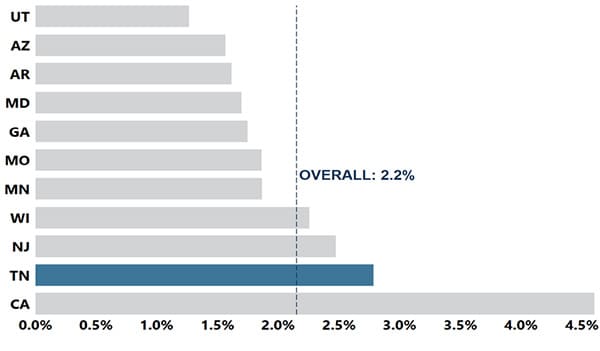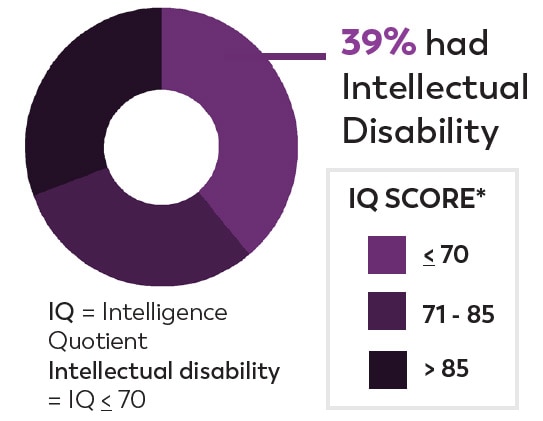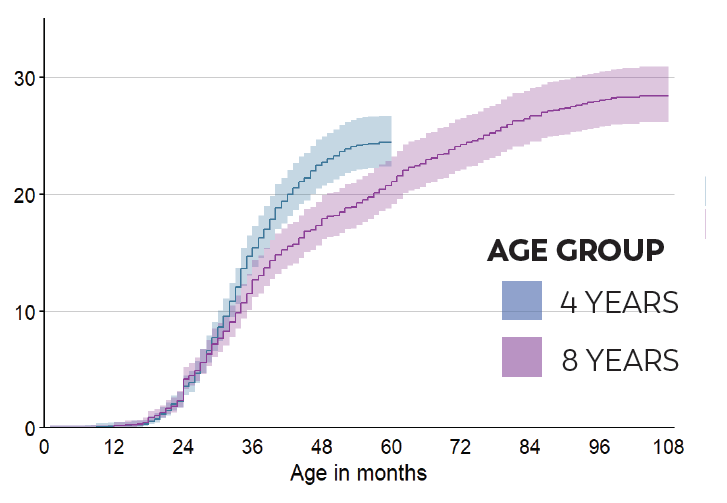A Snapshot of Autism Spectrum Disorder in New Jersey
‹View Table of Contents
Download and print this page [PDF – 219 KB, Print Only]
Findings from the New Jersey Autism Study help us to understand more about the number of children with autism spectrum disorder (ASD), the characteristics of those children and the age at which they are first evaluated and diagnosed.
![]() SITE TRACKING AREA
SITE TRACKING AREA
Or 2.9% of 8-year-old children in New Jersey were identified with ASD by in 2020.

This is higher than the average identified with ASD (2.8%) across US communities where the ADDM Network tracked ASD among school-age children.
1 in 40 or 2.5% of 4-yearold children were identified with ASD by NJAS.

This percentage is higher than the overall average percent identified with ASD (2.2%) in all communities tracked by the CDC.
were identified with ASD received a Comprehensive Developmental Evaluation by age 3 years.

Among NJAS 4-year-olds, Hispanic children were 1.9 times as likely to be identified with ASD and Black children were 1.4 times as likely to be identified
with ASD compared to White children.

Values indicate prevalence per 1000.
Among 8-year-olds, Hispanic, and Black children were 1.7 times as likely to be identified with ASD as White children.

Values indicate prevalence per 1000.
IQ data available for 63%
Of children identified with ASD by NJAS

Children aged 4 years were 1.3 times as likely to receive an ASD diagnosis by 48 months of age compared to children aged 8 years in NJAS.


The COVID-19 pandemic disrupted many aspects of life, including the ability to evaluate children for autism. Before the pandemic, 4-year-old children had higher ASD identification than 8-year-old children had when they were aged 4 years. In the first few months of the pandemic, 4-year-old children were less likely to have an evaluation than 8-year-old children had when they were the same age.
What are the key take-away messages from NJAS data?
- The ADDM Network ASD prevalence estimate was higher than the 2018 estimate.
- 2020 ASD prevalence estimates for 8-year-olds ranged from 2.3% (Maryland) to 4.5% (California). New Jersey had the third highest estimate (2.9%). These differences underscore the differences in ASD diagnoses across the ADDM Network.
- ASD estimates for 4-year-olds ranged from 1.3% (Utah) to 4.6% (California), in 2020, indicating differences in ASD diagnosis across the ADDM Network.
- Among 8-year-olds, the combined ADDM estimates showed ASD prevalence was higher for Black and Hispanic children compared with White children. More Black children with ASD also had intellectual disability compared with children from other racial ethnicity groups.
How can this information be useful?
The latest findings about ASD prevalence may be used to
- Raise awareness of increasing ASD in the United States.
- Quantify the scope of ASD across US regions.
- Provide New Jersey-specific information for service planning.
- Guide future research of ASD risk factors.
How and where was this information collected?
NJAS used a comprehensive record review method. Information is from 4- and 8-year-old old children who were diagnosed with ASD, as indicated in health and education records in two New Jersey counties, in 2020.
Tracking area
Essex, and Union counties
8-year-old children in tracking area: 18,940
- 27% White
- 31% Black
- 34% Hispanic
- 6% Asian or Pacific Islander
- <1% American Indian or Alaska Native
4-year-old children in tracking area: 19,120
- 26% White
- 29% Black
- 35% Hispanic
- 6% Asian or Pacific Islander
- <1% American Indian or Alaska Native
*Estimates may not sum to 100% due to rounding.
What else does the New Jersey Autism Study do besides provide ASD estimates?
NJAS used a comprehensive record review method. Information is from 4- and 8-year-old old children who were diagnosed with ASD, as indicated in health and education records in two New Jersey counties, in 2020.
“Rigorous surveillance research by the New Jersey Autism Study has provided a compelling foundation for statewide policy changes that have improved access to healthcare, education, treatment, and lifelong services. These supporting data and systemic changes are life-changing for children and adults with autism.”
– SUZANNE BUCHANAN, PsyD, BCBA-D
Executive Director, Autism New Jersey
Resources
AUTISM NEW JERSEY
Information, education, and policy initiatives related to ASD
800-4-AUTISM
www.autismnj.org
NJ EARLY INTERVENTION SYSTEM
Services for children under the age of 3 years with developmental delays or disabilities
www.nj.gov/health/fhs/eis/
AUTISM FAMILY SERVICES OF NEW JERSEY
Support services for families living with ASD
877-237-4477
www.autismfamilyservicesnj.org
NJ DEPARTMENT OF EDUCATION’S OFFICE OF SPECIAL EDUCATION PROGRAMS
Special education services for school-aged children with disabilities
www.nj.gov/education/specialed/
MOM2MOM
24/7 peer-support for parents of children with special needs
877-914-6662
www.mom2mom.us.com
STATEWIDE PARENT ADVOCACY NETWORK
Support for parents, including parents of children with special needs
800-654-7726
https://spanadvocacy.org
NJ PARENT LINK
Early childhood, parenting, and professional resource center
https://nj.gov/njparentlink/
CDC’S LEARN THE SIGNS. ACT EARLY.
Deepa Srinivasavaradan New Jersey Act Early Ambassador
https://www.cdc.gov/ncbddd/actearly/ambassadors-list.html
CONNECT WITH NJAS
Walter Zahorodny, PhD
Rutgers-New Jersey Medical School
185 South Orange Avenue, F570
Newark, New Jersey 07101
973-972-9773
zahorodn@njms.rutgers.edu
Pages in this Report
- 2023 Community Report on Autism
- Executive Summary
- Key Findings from the ADDM Network
- A Deeper Dive
- Spotlight On: Progress in Early Identification Disrupted during the COVID-19 Pandemic
- Spotlight On: A New Pattern in Racial and Ethnic Differences
- Data for Action
- ADDM Network Site Snapshots Overview
- A Snapshot of Autism Spectrum Disorder in Arizona
- A Snapshot of Autism Spectrum Disorder in Arkansas
- A Snapshot of Autism Spectrum Disorder in California
- A Snapshot of Autism Spectrum Disorder in Georgia
- A Snapshot of Autism Spectrum Disorder in Maryland
- A Snapshot of Autism Spectrum Disorder in Minnesota
- A Snapshot of Autism Spectrum Disorder in Missouri
- ›A Snapshot of Autism Spectrum Disorder in New Jersey
- A Snapshot of Autism Spectrum Disorder in Tennessee
- A Snapshot of Autism Spectrum Disorder in Utah
- A Snapshot of Autism Spectrum Disorder in Wisconsin
- Glossary
- References